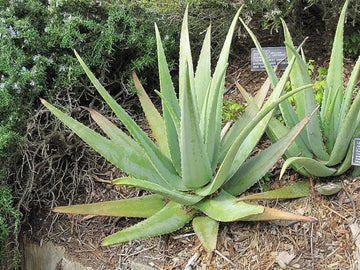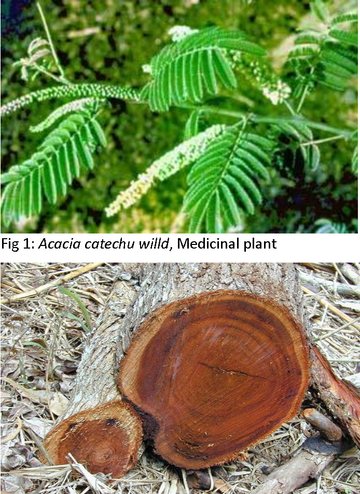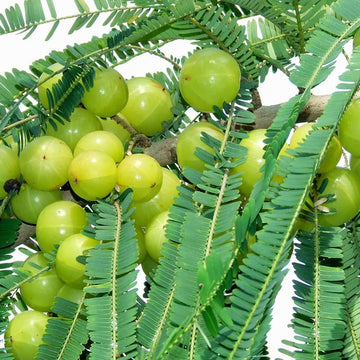ENGLISH NAME:- Barbados Aloe. Hindi- Ghee Kuar/Gwarpatha
SYNONYMS
Sanskrit : Kum¡r¢rasasambhava, Sah¡s¡ra
Assamese : Musabhar, Machambar
Bengali : Ghritakalmi
Gujrati : Eliyo, Eariyo
Hindi : Musabhar, Elva
Kannada : Karibola, Lolesara satva, Lovalsara, Lolesara
Kashmiri : Musabbar, Siber
Malayalam : Chenninayakam
Marathi : Korphad
Oriya : Musabara
Punjabi : Kalasohaga, Mussabar, Alua
Tamil : Kattazhi, Satthukkathazhai
Telugu : Musambaram
Urdu : Musabbar, Ailiva, Siber
BOTANICAL NAME - Aloe barbadensis miller
FAMILY - It belongs to Asphodelaceae (Liliaceae) family.
PARTS-USED:- Whole Plant, Dried juice and Pulp of Leaves.
DESCRIPTION:- A small herb with stolon, fleshy and radical leaves, flowers pinkish red on long scape.
Its shrub is 1-2 feet high. Leaves-15 inches long, 4 inches wide, inch thick, fleshy, spiny-toothed, circular or double Densely arranged in rows. There is a posterior pith like ghee inside the leaves. A long flower flag emerges from the middle of the flower in which bloody flowers appear. Flowers and fruits appear at the end of winter.
The components of the mature flower come together to form a cylindrical or bell-shaped tube. Stamens, equal to or longer than the anthers, are inserted into a groove of the stamen connector. Fruits are loculicidal. When its leaves are cut, a yellow juice comes out which solidifies when cooled. It is called 'Kumari-saar'.
Generally it is manufactured in two ways. When the juice is heated in sunlight or on low flame, an opaque, waxy substance is obtained which is called Hepatic aloes. But when the juice is dried quickly on high heat, a semi-transparent substance is obtained which is called glassy aloes. It is soluble in alcohol and should not contain more than 5% ash.
Species – Three types of aloe are approved in the Indian Pharmacopoeia:
1. Curaccao Aloes – It is obtained from Aloe Vera plant and is opaque, brown-black in color.
2. Socotrine aloes - This aloe is obtained from the Perry (A. perryi Baker) plant and is bloody-black or brownish-black, opaque and shiny.
3. Cape aloes – This aloe is obtained from ferox (A. ferox Mill.) or its hybrid plants. It is a dark or greenish brown powder. When mixed with glycerine, innumerable crystalline particles are visible in the brown medium.
Apart from these, there are other species like Natal, Moka, Jafarabadi etc. 2-3 types of Indian species are also found. Var.chinensis Baker occurs in South India and Central India. Its leaf base is purple and the thorns are not sharp. var. littoralis Koeing ex Baker is found in the coastal area from Madras to Rameshwar and its leaves are small and serrated. One type is found in Kathiawar region from which Jafrabadi aloe is obtained. A similar plant is A. variegata Linn. It is found in Maharashtra whose leaves are large, with sharp thorns and white spots on the base of the leaves.
Place of Origin - Its native place is North Africa, Canary Islands and Spain from where it has spread to countries like Western Archipelago, India, China etc. Samprati is found everywhere in India. Earlier it was imported from Africa and Germany but now it has stopped.
TASTE:- Bitter.
CHEMICAL CONSTITUENTS-Leaves Contain: Carbohydrates, Tannins, Proteins Chromones (Abesin and Aloesone), Malic acid, Citric acid, Tartaric acid, Jelly from Leaves Contain: Acetylated glucomannans, Iron, Calcium, Potassium and Magnesium.
DESCRIPTION
a) Macroscopic
Dark chocolate brown, to black, compact, irregular masses: surface dull, opaque
with slightly vitreous appearance, odour, characteristic, taste, nauseous and bitter.
b) Microscopic
Powder when mounted in glycerine or lactophenol and examined under the microscope shows innumerable crystalline, yellowish-brown to chocolate coloured particles of varying size and shape.
IDENTITY, PURITY AND STRENGTH
Identification:
Mix 0.5 g with 50 ml of water, boil until nearly dissolved, cool, add 0.5 g of Kieselguhr and filter, to the filtrate apply the following tests-
(i) Heat 5 ml of filtrate with 0.2 g of Borax until dissolved, add a few drops of this solution to a test-tube nearly filled with Water, a green fluorescence is produced.
(ii) Mix 2 ml of filtrate with 2 ml of a freshly prepared solution of Bromine, a pale
yellow precipitate is produced.
ACTIONS: Purgative, Carminative, Digestive, Tonic, Anti-inflammatory, Analgesic.
USED IN:-The pulp is used to cure: Piles, Rectal fissures, Cough, Cold, Rheumatism, Constipation, Fevers, Colic, Menstrual disorder, It is also stomachic, Anthelmintic, Hepatoprotective, Uterus Stimulant, Hypotensive.




